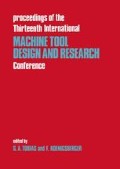Summary
The specimen obtained by a tool quick-stop device should not be grossly influenced by the stopping conditions. Some previous investigators have reported measurements of extremely high deceleration rates for explosive quick-stop devices. However, these measurements are open to doubt since nearly all assume a uniform acceleration for the first few thousandths of an inch of tool displacement, and also, it can be shown that the reported accelerations would require explosive ‘shot start’ pressures and energies higher than seems possible.
The instantaneous chamber pressure and the displacement—time behaviour of an explosive quick-stop device have been investigated using a piezoelectric pressure transducer and a photo-optic comparator. The initial acceleration is shown to be highly non-uniform, with acceleration rates of around 105 and 106 in/s2 in the first few thousandths of an inch of displacement (the stage of tool disengagement). The influence of variation in explosive charge weight, chamber volume and shearpin size is reported.
Preview
Unable to display preview. Download preview PDF.
References
W. F. Hastings, 1957. A new quick-stop device and grid technique for metal cutting research. Annals CIRP, 15, p. 109.
M. G. Stevenson and P. L. B. Oxley, 1969/70. An experimental investigation of the influence of speed and scale on the strain-rate in a zone of intense plastic deformation. Proc. Inst. Mech. Engrs., 184, p. 561.
P. K. Philip, 1971. Study of the performance characteristics of an explosive quick-stop device for freezing cutting action. Int. J. Mach. Tool Des. Res., 11, p. 133.
J. Ellis, R. Kirk and G. Barrow, 1969. The development of a quick-stop device for metal cutting research. Int. J. Mach. Tool Des. Res., 9, p. 321.
J. E. Williams, E. F. Smart and D. R. Milner, 1970. The metallurgy of machining, Part 1: basic considerations and the cutting of pure metals. Metallurgia, 81, p. 483.
C. Spaans, 1971. The fundamentals of three-dimensional chip curl, chip breaking and chip control. Department of Mechanical Engineering, Delft University of Technology, Report WTHD No. 24, p. 15.
C. A. Gladman and F. J. Bramall. Discussion contributed to reference 2.
J. S. Rinehart and J. Pearson, 1963. Explosive working of metals. Pergamon Press, Oxford.
R. Komanduri and R. H. Brown, 1972. Microcrack formation in machining a low carbon steel. Paper submitted to Annals CIRP.
Author information
Authors and Affiliations
Editor information
Editors and Affiliations
Copyright information
© 1973 Macmillan Publishers Limited
About this chapter
Cite this chapter
Brown, R.H., Komanduri, R. (1973). An Investigation of the Performance of a Quick-Stop Device for Metal Cutting Studies. In: Tobias, S.A., Koenigsberger, F. (eds) Proceedings of the Thirteenth International Machine Tool Design and Research Conference. Palgrave, London. https://doi.org/10.1007/978-1-349-01857-4_33
Download citation
DOI: https://doi.org/10.1007/978-1-349-01857-4_33
Publisher Name: Palgrave, London
Print ISBN: 978-1-349-01859-8
Online ISBN: 978-1-349-01857-4
eBook Packages: EngineeringEngineering (R0)

